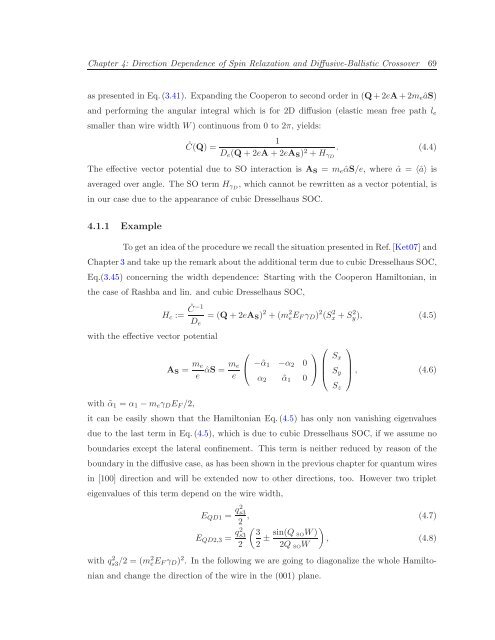Itinerant Spin Dynamics in Structures of ... - Jacobs University
Itinerant Spin Dynamics in Structures of ... - Jacobs University
Itinerant Spin Dynamics in Structures of ... - Jacobs University
Create successful ePaper yourself
Turn your PDF publications into a flip-book with our unique Google optimized e-Paper software.
Chapter 4: Direction Dependence <strong>of</strong> <strong>Sp<strong>in</strong></strong> Relaxation and Diffusive-Ballistic Crossover 69<br />
as presented <strong>in</strong> Eq.(3.41). Expand<strong>in</strong>g the Cooperon to second order <strong>in</strong> (Q+2eA+2m e âS)<br />
and perform<strong>in</strong>g the angular <strong>in</strong>tegral which is for 2D diffusion (elastic mean free path l e<br />
smaller than wire width W) cont<strong>in</strong>uous from 0 to 2π, yields:<br />
Ĉ(Q) =<br />
1<br />
D e (Q+2eA+2eA S ) 2 +H γD<br />
. (4.4)<br />
The effective vector potential due to SO <strong>in</strong>teraction is A S = m eˆαS/e, where ˆα = 〈â〉 is<br />
averaged over angle. The SO term H γD , which cannot be rewritten as a vector potential, is<br />
<strong>in</strong> our case due to the appearance <strong>of</strong> cubic Dresselhaus SOC.<br />
4.1.1 Example<br />
Toget anidea<strong>of</strong>theprocedurewerecall thesituation presented<strong>in</strong>Ref.[Ket07] and<br />
Chapter3 and take up the remark about the additional term due to cubic Dresselhaus SOC,<br />
Eq.(3.45) concern<strong>in</strong>g the width dependence: Start<strong>in</strong>g with the Cooperon Hamiltonian, <strong>in</strong><br />
the case <strong>of</strong> Rashba and l<strong>in</strong>. and cubic Dresselhaus SOC,<br />
with the effective vector potential<br />
with ˜α 1 = α 1 −m e γ D E F /2,<br />
H c := Ĉ−1<br />
= (Q+2eA S ) 2 +(m 2 e<br />
D E Fγ D ) 2 (Sx 2 +S2 y ), (4.5)<br />
e<br />
A S = m e<br />
e ˆαS = m e<br />
e<br />
⎛<br />
⎝ −˜α 1 −α 2 0<br />
α 2 ˜α 1 0<br />
⎛ ⎞<br />
⎞ S x<br />
⎠⎜<br />
⎝ S y<br />
⎟<br />
⎠ , (4.6)<br />
S z<br />
it can be easily shown that the Hamiltonian Eq.(4.5) has only non vanish<strong>in</strong>g eigenvalues<br />
due to the last term <strong>in</strong> Eq.(4.5), which is due to cubic Dresselhaus SOC, if we assume no<br />
boundaries except the lateral conf<strong>in</strong>ement. This term is neither reduced by reason <strong>of</strong> the<br />
boundary<strong>in</strong> the diffusive case, as has been shown <strong>in</strong> the previous chapter for quantum wires<br />
<strong>in</strong> [100] direction and will be extended now to other directions, too. However two triplet<br />
eigenvalues <strong>of</strong> this term depend on the wire width,<br />
E QD1 = q2 s3<br />
2 , (4.7)<br />
(<br />
E QD2,3 = q2 s3 3<br />
2 2 ± s<strong>in</strong>(Q )<br />
SOW)<br />
, (4.8)<br />
2Q SO W<br />
with q 2 s3 /2 = (m2 e E Fγ D ) 2 . In the follow<strong>in</strong>g we are go<strong>in</strong>g to diagonalize the whole Hamiltonian<br />
and change the direction <strong>of</strong> the wire <strong>in</strong> the (001) plane.
















